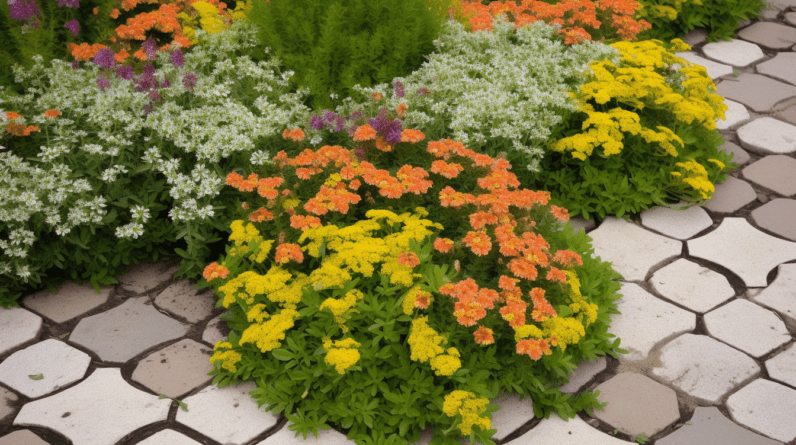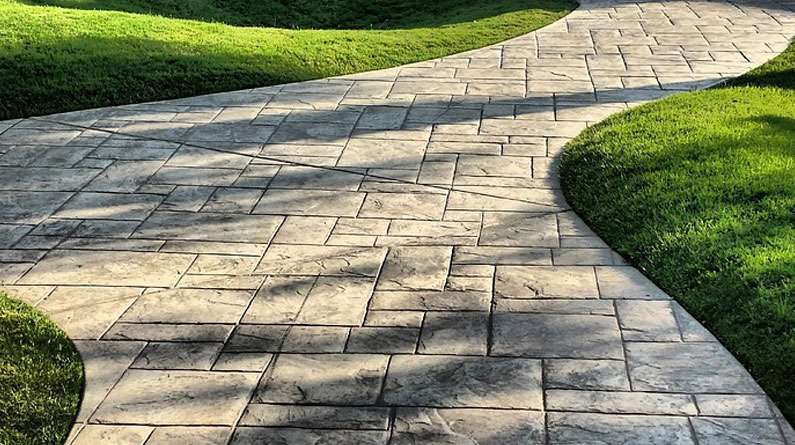
When looking to enhance your outdoor space, think about the subtle charm and eco-friendly advantages of constructing a sustainable garden path with recycled materials. Picture the opportunity to turn old items into a practical and visually appealing walkway that not only saves resources but also brings a unique touch to your landscape.
By discovering creative ways to reuse materials, you can embark on a journey towards a more environmentally conscious and visually pleasing garden path that blends seamlessly with the natural surroundings. For instance, you could use reclaimed wood from old furniture to create rustic stepping stones or repurpose broken ceramic tiles to design a mosaic pathway.
These recycled materials not only add a personal touch to your garden but also contribute to reducing waste and promoting sustainability in your outdoor space.
Key Takeaways
- Embrace sustainability in your garden by creating a beautiful pathway using recycled materials.
- Reduce waste and demonstrate your creativity by repurposing items like old bricks, broken tiles, or reclaimed wood for a unique and eco-friendly pathway.
- Lower your carbon footprint and promote environmental consciousness by choosing materials that would otherwise end up in a landfill.
- Add a touch of charm to your garden while telling a story through the upcycled materials used in your pathway.
- By setting an eco-friendly example, you not only save natural resources but also inspire others to follow suit in their own gardens.
Benefits of Using Recycled Materials
Using recycled materials in your garden path is a great way to help the environment and make your outdoor space stand out. When you choose to use materials like broken concrete, old bricks, or reclaimed wood, you're reducing waste and showing your commitment to sustainability.
By repurposing these materials, you're lowering your carbon footprint and saving natural resources. Instead of ending up in landfills, these items can be turned into a beautiful pathway that adds charm to your garden. This not only benefits the planet but also allows you to showcase your creativity and design skills.
Incorporating recycled materials into your garden path adds a unique touch and tells a story. Each element has its own history, making your pathway one-of-a-kind. By choosing to use these materials, you aren't only helping the environment but also setting an example for others to follow and encouraging eco-friendly practices in your community.
Types of Recycled Materials for Paths
Creating an environmentally friendly and visually appealing garden path involves using a variety of recycled materials like broken concrete, old bricks, reclaimed wood planks, crushed gravel, rocks, and discarded ceramic tiles. By incorporating these materials, you not only add a unique touch to your garden but also contribute to sustainability by repurposing items that would otherwise be discarded. Here are some commonly used recycled materials for eco-friendly pathways:
- Broken Concrete Pieces: These pieces can be creatively arranged in different patterns to give your garden path a rugged and industrial look. For example, you can create a mosaic-like design using different shapes and sizes of broken concrete.
- Reclaimed Wood Planks: Old wooden planks can bring a rustic charm to your pathway, providing a natural and textured appearance. To enhance the aesthetic appeal, you can choose weathered wood planks with interesting grain patterns and knots.
- Discarded Ceramic Tiles: Unused ceramic tiles can be artfully arranged to form colorful and artistic paths in your garden. For instance, you can create a geometric pattern using tiles of various colors or a floral design using different shapes of tiles.
Design Ideas for Recycled Paths
Discover creative design concepts that turn reused materials into captivating walkways for your garden. The options for designing recycled paths are vast and exciting. Try incorporating playful zig-zag patterns with a mix of colors to bring a fun element to your garden. Puzzle brick arrangements can create a modern and intriguing path. Terracotta pieces can add a rustic charm that complements the natural ambiance of your garden beautifully.
For a more minimalist and abstract design, consider using clean lines and simple shapes with recycled materials such as old bricks or reclaimed wood planks. Mosaic patterns or upcycled ceramic designs can introduce a burst of color and artistic flair to your garden path. To add a touch of whimsy, repurpose plastic bottles or bottle caps for unique decorations. Painted bottles in vibrant colors can also be reused as delightful markers along the path.
Enhance the visual appeal of your recycled path by incorporating rocks, potted plants, benches, and ground covers. DIY instructions for crafting these paths are easy to follow, providing step-by-step guidance for creating a sustainable and visually pleasing garden path effortlessly. Whether you opt for a puzzle brick path, terracotta fractions path, or a path made of recycled stepping stones, the key is to express your creativity while being mindful of the environment.
Step-by-Step Guide for Installation
When you begin setting up your eco-friendly garden path using recycled materials, the first step is to clear the path area of any debris, plants, or objects that could get in the way.
Here's a simple guide to creating a one-of-a-kind garden path with recycled materials:
- Prepare the Ground: Start by making sure the ground is flat and even to provide a solid base for your path. This will help keep the recycled materials stable and secure.
- Add a Strong Base: Use crushed gravel or sand as a foundation for the recycled materials. This base layer will help prevent the path from shifting or sinking over time, ensuring its durability.
- Design and Secure the Materials: Arrange the recycled materials in a design that complements your garden style. You can use items like old bricks, tiles, or even glass bottles to create a unique look. Once you're happy with the layout, secure the materials in place using adhesive or mortar to make sure they stay put.
Maintenance Tips for Sustainable Paths
To effectively maintain your eco-friendly garden path crafted from recycled materials, it's crucial to prioritize regular cleaning and timely repairs to uphold its appearance and functionality. By consistently sweeping and tidying up your path, you not only ensure a neat look but also prevent any debris from piling up and causing potential risks. Promptly fixing any damaged recycled materials is essential to guarantee the path remains safe and strong for all users. Replacing worn-out elements with fresh recycled materials can prolong the path's lifespan while staying true to its sustainable essence.
To preserve the fresh and well-kept look of your path, consider reapplying paint or embellishments when necessary. This not only revitalizes the appearance but also helps in preventing deterioration over time. Moreover, ensuring proper drainage and stability of the path materials is vital for long-term maintenance. Adequate drainage prevents water accumulation, which can weaken the materials, while a stable foundation keeps the path secure and reliable for walking.
For instance, if you notice any cracks in the recycled material, filling them promptly with suitable filler can prevent further damage and maintain the path's integrity. Additionally, adding a layer of protective sealant over the path can help in preserving its color and texture, ensuring it remains visually appealing for an extended period. By taking these proactive steps, you can ensure your sustainable garden path continues to enhance your outdoor space while minimizing environmental impact.
Frequently Asked Questions
What Recycled Materials Can You Use for a Garden Path?
Creating a distinctive garden pathway can be achieved by using a variety of recycled materials. For instance, you can repurpose tire treads to add a rugged and durable element to your path. Additionally, glass bottles can be creatively arranged to bring a touch of color and whimsy to the environment. Wine corks offer a unique texture and can be embedded into the pathway for added visual interest.
If you're looking for a more flexible and weather-resistant option, consider using plastic bags woven together to form a sturdy and environmentally friendly surface. Ceramic tiles can also be incorporated to provide a polished and elegant look to your garden path. Lastly, metal cans can be repurposed to create a rustic and industrial aesthetic, adding a touch of charm to the overall design.
How Do You Make a Garden Out of Recycled Materials?
Creating a garden from recycled materials involves repurposing items like old tiles, reclaimed wood, salvaged bricks, recycled glass, eco-friendly pavers, and sustainable gravel. For a unique touch, consider using materials such as beer bottles, plastic bottles, or reclaimed wooden planks for creating distinctive garden pathways. By upcycling these materials, you can not only add a sustainable touch to your garden but also showcase your creativity through innovative design choices.
What Is the Cheapest Way to Make a Garden Path?
Creating an affordable garden path can be achieved by using recycled materials. You can explore various do-it-yourself methods to transform old items like bricks, wood, or plastic bottles into a charming pathway. Consider cost-effective and environmentally friendly options to create sustainable trails with distinctive styles. For instance, repurposing old bricks from a construction site or using reclaimed wood from pallets can add a rustic touch to your garden path. Additionally, incorporating plastic bottles filled with sand or gravel can create a unique and budget-friendly edging for your pathway. Embracing these creative ideas can help you design a beautiful garden path without breaking the bank.
What Is the Best Material for a Garden Path?
If you're thinking about building a garden path, there are several materials you can choose from to suit your needs. Stone pavers are a great option if you're looking for something durable and long-lasting. They come in a variety of shapes and sizes, making it easy to create a unique and beautiful pathway in your garden.
For a more natural look, consider using wood chips. They can add a rustic charm to your garden while providing a soft surface to walk on. Wood chips also help with moisture retention in the soil, making them a practical choice for your garden path.
Gravel pathways are a popular choice for those who want a low-maintenance option. They are easy to install and require minimal upkeep. Gravel pathways also allow for good drainage, which can help prevent waterlogging in your garden.
If you're looking to add charm to your garden, brick walkways are a classic choice. They come in a variety of colors and patterns, allowing you to create a timeless and elegant pathway in your garden.
For a more modern appeal, consider using concrete stepping stones. They are versatile and can be customized in various shapes and designs. Concrete stepping stones are also durable and easy to maintain, making them a practical choice for a garden path.
Lastly, if you want to add a softer touch to your garden path, consider using mulch trails. Mulch not only provides a comfortable surface to walk on but also helps to retain moisture in the soil and suppress weeds.
When choosing the best material for your garden path, consider the style of your garden, the amount of foot traffic it will receive, and your personal preferences. Each material has its own unique benefits, so take the time to choose the one that best suits your needs.











